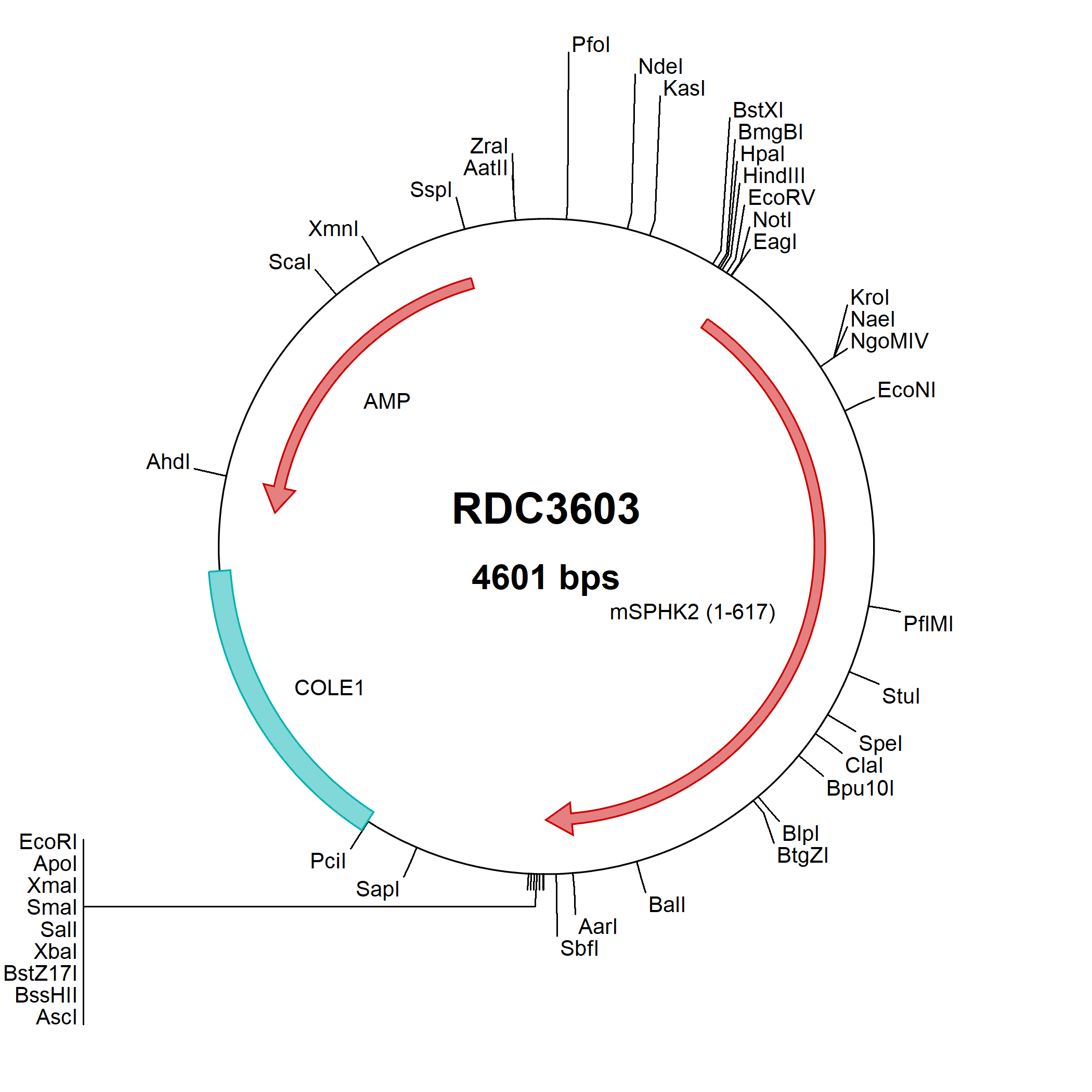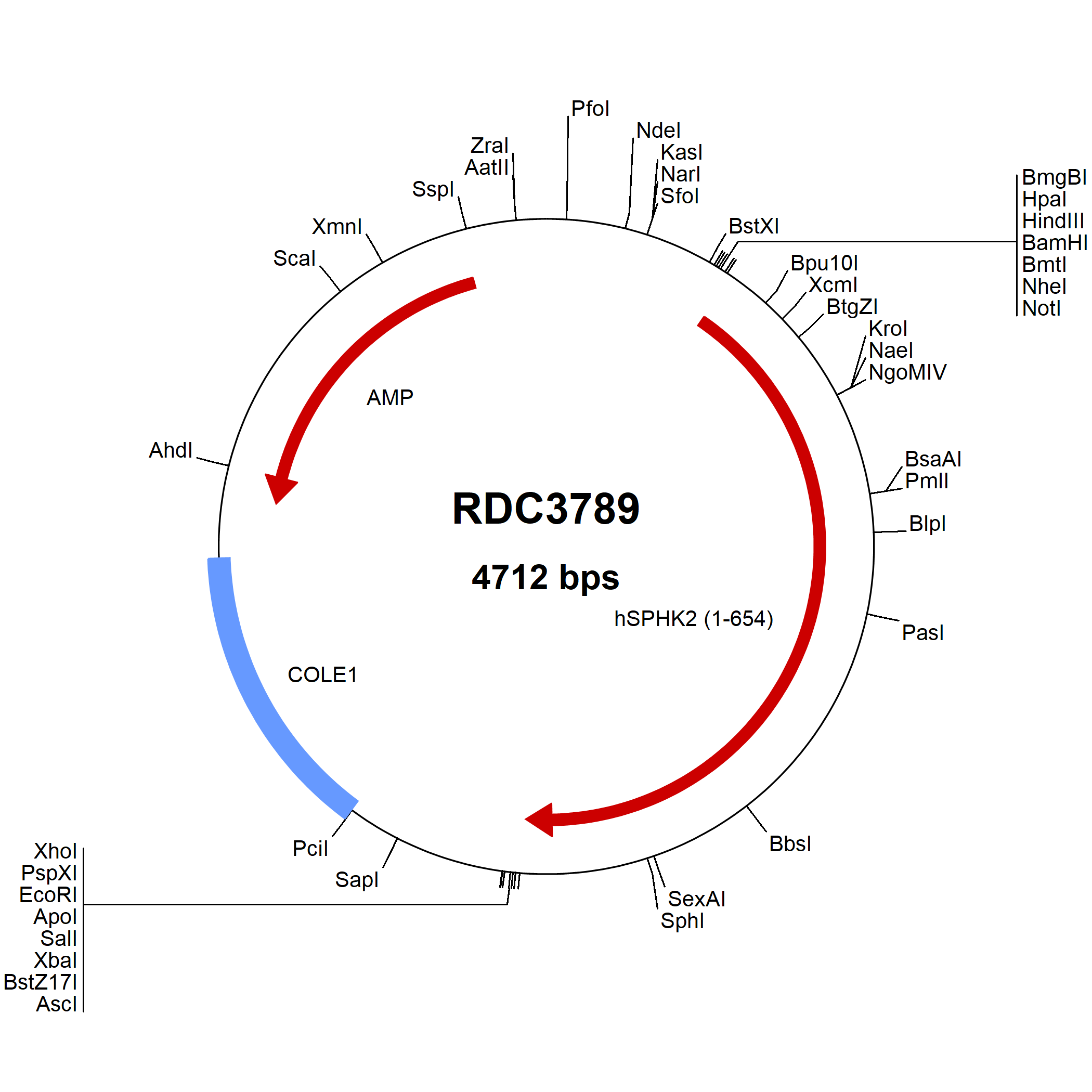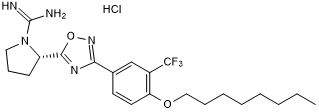Sphingosine Kinase 2/SPHK2 Products
Sphingosine Kinase 2 (SPHK2) is one of two enzymes that catalyze the phosphorylation of Sphingosine to form Sphingosine 1-phosphate (S1P). SPHK2 is 654 amino acids (aa) in length with a predicted molecular mass of 69 kDa. The mouse and rat orthologs share 84% and 85% aa sequence identity with the human protein, respectively. Three human SPHK2 splice variants have been identified. While both SPHK1 and SPHK2 generate S1P, the effects of SPHK2 signaling oppose those of SPHK1. SPHK1 activation results in cell proliferation and prevents apoptosis, and SPHK2 activation inhibits cell proliferation and promotes apoptosis. SPHK1 is primarily localized to the cytoplasm and plasma membrane, while SPHK2 is primarily localized to the endoplasmic reticulum. These differences in their localization may contribute to the differences in their signaling. As SPHK activity affects a wide range of biological processes including development, the immune response, and tumorigenesis, SPHK inhibition is a therapeutic target of interest.
22 results for "Sphingosine Kinase 2/SPHK2" in Products
22 results for "Sphingosine Kinase 2/SPHK2" in Products
Sphingosine Kinase 2/SPHK2 Products
Sphingosine Kinase 2 (SPHK2) is one of two enzymes that catalyze the phosphorylation of Sphingosine to form Sphingosine 1-phosphate (S1P). SPHK2 is 654 amino acids (aa) in length with a predicted molecular mass of 69 kDa. The mouse and rat orthologs share 84% and 85% aa sequence identity with the human protein, respectively. Three human SPHK2 splice variants have been identified. While both SPHK1 and SPHK2 generate S1P, the effects of SPHK2 signaling oppose those of SPHK1. SPHK1 activation results in cell proliferation and prevents apoptosis, and SPHK2 activation inhibits cell proliferation and promotes apoptosis. SPHK1 is primarily localized to the cytoplasm and plasma membrane, while SPHK2 is primarily localized to the endoplasmic reticulum. These differences in their localization may contribute to the differences in their signaling. As SPHK activity affects a wide range of biological processes including development, the immune response, and tumorigenesis, SPHK inhibition is a therapeutic target of interest.
| Reactivity: | Human |
| Details: | Mouse IgG1 Monoclonal Clone #9C5E1 |
| Applications: | IHC, WB, ELISA, ICC/IF, Flow, +1 More |
| Reactivity: | Human, Mouse, Rat |
| Details: | Mouse IgG1 Monoclonal Clone #M532 |
| Applications: | WB |
| Source: | Sf 21 (baculovirus) |
| Accession #: | Q9NRA0 |
| Reactivity: | Human |
| Details: | Mouse IgG1 Monoclonal Clone #3C8D3 |
| Applications: | IHC, ELISA, ICC/IF, Flow, CyTOF-ready |
| Reactivity: | Human, Mouse, Rat |
| Details: | Rabbit IgG Polyclonal |
| Applications: | WB, ICC/IF, IP |
| Source: | Sf 21 (baculovirus) |
| Accession #: | Q9JIA7 |
| Applications: | EnzAct |
| Applications: | WB |
| Reactivity: | Human, Mouse, Rat |
| Details: | Rabbit IgG Polyclonal |
| Applications: | WB |
| Reactivity: | Human, Mouse, Rat |
| Details: | Rabbit IgG Polyclonal |
| Applications: | WB, ELISA |
| Reactivity: | Human |
| Details: | Mouse IgG Polyclonal |
| Applications: | WB |
| Reactivity: | Human |
| Details: | Rabbit IgG Polyclonal |
| Applications: | WB |
| Reactivity: | Human |
| Details: | Rabbit IgG Polyclonal |
| Applications: | WB, ELISA |
| Reactivity: | Human |
| Details: | Rabbit IgG Polyclonal |
| Applications: | WB |
| Reactivity: | Human |
| Details: | Rabbit IgG Polyclonal |
| Applications: | ICC/IF |
| Reactivity: | Human |
| Details: | Rabbit IgG Polyclonal |
| Applications: | ICC/IF |
| Reactivity: | Human |
| Details: | Rabbit Polyclonal |
| Applications: | WB, ELISA |
| Applications: | AC |
| Applications: | AC |
Selective sphingosine kinase 2 (Sphk2) inhibitor
| Chemical Name: | (2S)-2-[3-[4-(Octyloxy)-3-(trifluoromethyl)phenyl]-1,2,4-oxadiazol-5-yl]-1-pyrrolidinecarboximidamide hydrochloride |
| Purity: | ≥98% (HPLC) |
Selective non-lipid inhibitor of sphingosine kinase
| Chemical Name: | 4-[[4-(4-Chlorophenyl)-2-thiazolyl]amino]phenol |
| Purity: | ≥98% (HPLC) |

![Immunocytochemistry/ Immunofluorescence: Sphingosine Kinase 2/SPHK2 Antibody (9C5E1) - BSA Free [NBP2-52567] Immunocytochemistry/ Immunofluorescence: Sphingosine Kinase 2/SPHK2 Antibody (9C5E1) - BSA Free [NBP2-52567]](https://resources.bio-techne.com/images/products/Sphingosine-Kinase-2-SPHK2-Antibody-9C5E1-Immunocytochemistry-Immunofluorescence-NBP2-52567-img0004.jpg)
![Western Blot: Sphingosine Kinase 2/SPHK2 Antibody (M532) [NBP3-23422] - Sphingosine Kinase 2/SPHK2 Antibody (M532)](https://resources.bio-techne.com/images/products/nbp3-23422_mouse-sphingosine-kinase-2-sphk2-mab-m532-19920231915420.jpg)


![Immunocytochemistry/ Immunofluorescence: Sphingosine Kinase 2/SPHK2 Antibody (3C8D3) - BSA Free [NBP2-52566] Immunocytochemistry/ Immunofluorescence: Sphingosine Kinase 2/SPHK2 Antibody (3C8D3) - BSA Free [NBP2-52566]](https://resources.bio-techne.com/images/products/Sphingosine-Kinase-2-SPHK2-Antibody-3C8D3-Immunofluorescence-NBP2-52566-img0002.jpg)
![Western Blot: Sphingosine Kinase 2/SPHK2 Antibody [NBP3-23423] - Sphingosine Kinase 2/SPHK2 Antibody](https://resources.bio-techne.com/images/products/nbp3-23423_rabbit-sphingosine-kinase-2-sphk2-pab-199202317594414.jpg)
![Western Blot: Sphingosine Kinase 2/SPHK2 [p Thr578] Antibody [NBP3-23393] - Sphingosine Kinase 2/SPHK2 [p Thr578] Antibody](https://resources.bio-techne.com/images/products/nbp3-23393_rabbit-sphingosine-kinase-2-sphk2-p-thr578-pab-19920231992821.jpg)
![Western Blot: Sphingosine Kinase 2/SPHK2 Antibody [NBP3-30857] - Sphingosine Kinase 2/SPHK2 Antibody](https://resources.bio-techne.com/images/products/nbp3-30857_rabbit-sphingosine-kinase-2-sphk2-pab-811202420592142.jpg)
![Western Blot: Sphingosine Kinase 2/SPHK2 Antibody [H00056848-B01P] Western Blot: Sphingosine Kinase 2/SPHK2 Antibody [H00056848-B01P]](https://resources.bio-techne.com/images/products/Sphingosine-Kinase-2-SPHK2-Antibody-Western-Blot-H00056848-B01P-img0003.jpg)
![Western Blot: Sphingosine Kinase 2/SPHK2 Antibody [H00056848-D01P] Western Blot: Sphingosine Kinase 2/SPHK2 Antibody [H00056848-D01P]](https://resources.bio-techne.com/images/products/Sphingosine-Kinase-2-SPHK2-Antibody-Western-Blot-H00056848-D01P-img0001.jpg)
![Western Blot: Sphingosine Kinase 2/SPHK2 Antibody [NBP3-30886] - Sphingosine Kinase 2/SPHK2 Antibody](https://resources.bio-techne.com/images/products/nbp3-30886_rabbit-sphingosine-kinase-2-sphk2-pab-811202420594231.jpg)
![Western Blot: Sphingosine Kinase 2/SPHK2 Antibody [NBP1-33085] Western Blot: Sphingosine Kinase 2/SPHK2 Antibody [NBP1-33085]](https://resources.bio-techne.com/images/products/Sphingosine-Kinase-2-SPHK2-Antibody-Western-Blot-NBP1-33085-img0004.jpg)
![Immunocytochemistry/ Immunofluorescence: Sphingosine Kinase 2/SPHK2 Antibody [NBP3-17771] Immunocytochemistry/ Immunofluorescence: Sphingosine Kinase 2/SPHK2 Antibody [NBP3-17771]](https://resources.bio-techne.com/images/products/Sphingosine-Kinase-2-SPHK2-Antibody-Immunocytochemistry-Immunofluorescence-NBP3-17771-img0001.jpg)
![Immunocytochemistry/ Immunofluorescence: Sphingosine Kinase 2/SPHK2 Antibody [NBP2-57035] Immunocytochemistry/ Immunofluorescence: Sphingosine Kinase 2/SPHK2 Antibody [NBP2-57035]](https://resources.bio-techne.com/images/products/Sphingosine-Kinase-2-SPHK2-Antibody-Immunocytochemistry-Immunofluorescence-NBP2-57035-img0001.jpg)





